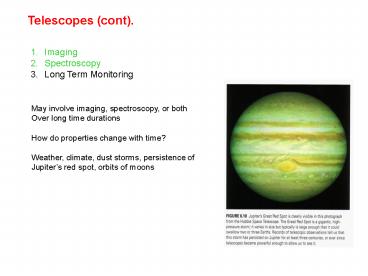Telescopes (cont). - PowerPoint PPT Presentation
1 / 11
Title:
Telescopes (cont).
Description:
Weather, climate, dust storms, persistence of Jupiter's red ... Huygens Probe. Biological Tour of the Solar System (Intro) Terrestrial Planets and their moons ... – PowerPoint PPT presentation
Number of Views:23
Avg rating:3.0/5.0
Title: Telescopes (cont).
1
Telescopes (cont).
- Imaging
- Spectroscopy
- Long Term Monitoring
May involve imaging, spectroscopy, or both Over
long time durations How do properties change
with time? Weather, climate, dust storms,
persistence of Jupiters red spot, orbits of moons
2
- Discovered Jupiters rings
- Details of Saturns, Uranus and Neptunes rings
- Measured magnetic fields as function of distance
- Gravitational effect by moons measure moon
densities
Robotic Spacecraft
Some of these measurements are backlit from the
sun, i.e. in silhouette- cannot be done from
Earth at all
The Flyby, short duration close up study..
Voyager 2 flew by Jupiter July 9,
1997 Saturn Aug 25, 1981 Uranus Jan
24, 1986 Neptune Aug 25, 1989
Orbiters can give long term monitoring, but
they are much more expensive
3
Robotic Spacecraft
Landers on the other hand, stick around and
move around on a surface. Close up and Personal!
Probes on the other hand, go in and dont come
back! Close up and Personal!
- Galileo Probe dropped into the atmosphere of
Jupiter (1995) - Collected
- Temperature
- Wind Speeds
- Pressure
- Composition
- Radiation levels
- As a function of depth for about an hour before
it was destroyed
New generations Landers are soft landing rovers
4
Robotic Spacecraft to Come
This summer!
Cassini Orbiter Huygens Probe
5
(No Transcript)
6
Biological Tour of the Solar System (Intro)
- Terrestrial Planets and their moons
- Mercury (like the moon?)
- Venus (like the Earth once?)
- Earths Moon
- Mars (like the Earth once?)
- Mars Moons
- JOVIAN PLANETS--- later date.
7
Mercury and Earths Moon
Mercury and Moon are least likely habitats
- small, lost internal heat
- no outgassing- no atmospheres
- scared with craters, surfaces are old
- evidence for impacts suggest that some organics
and water deposited on these bodies
However.
8
Evidence for Permafrost Water on Lunar Poles?
This color-coded map from the Lunar Prospector
mission shows evidence for water-ice in craters
near the Moons North pole. (late 1990). Used
neutron detection techniques. Dark blue and
purple regions have highest hydrogen
concentrations, which may be due to water
concentrations on or just below the surface.
In these regions, some craters are permanently
shielded from the Sun. Similar results were
found on the Moons south pole. We have no
corresponding probe of Mercury
9
Venus Earths Sister
Magellan Orbiter Radio Maps
- 2/3 the distance from Sun as Earth
- 80 mass of Earth
- Calculations predicted 35C temperature
As we know, Venus suffers a runaway greenhouse
effect (discuss details of how it got there in Ch
9)
Surface is very young, regenerates every so
often, last time was 1 billion years ago
Earth 1 carbon dioxide Venus 96 carbon
dioxide Venus too hot for liquid water, ammonia,
methane, or ethane
Venera Lander Photo (and then sphttthht!)
Early oceans on Venus? Discuss implications
later
10
Volcanisms occurs on Venus, but no plate
tectonics!
11
Small Moons
Mars two moons are Phobos and Deimos Objects
like these most certainly lack liquids Too small
to have internal heat that would energize
metabolism or allow for liquid
Meteorites must have contained liquid water
shortly after their formation, and these objects
contain organic molecules on them from space
(formation). Early life on these bodies would
seem very unlikely. These very small moons and
asteroids too far from sun to have any ice water
melt in the current epoch.































